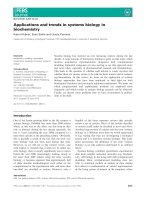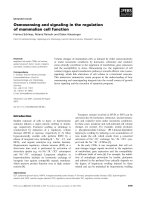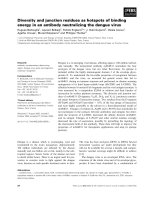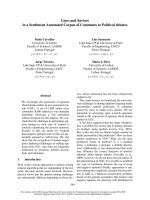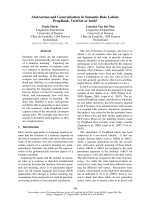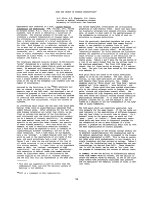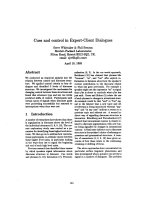Báo cáo khoa học: "Lexicon and grammar in probabilistic tagging of written English" doc
Bạn đang xem bản rút gọn của tài liệu. Xem và tải ngay bản đầy đủ của tài liệu tại đây (427.37 KB, 6 trang )
Lexicon and grammar in probabilistic tagging
of written English.
Andrew David Be, ale
Unit for Compum" ~ on the English Languase
Univenity of ~r
Bailngg,
Lancaster
England LAI 4Yr
mb0250~ az.~c~vaxl
Abstract
The paper describes the development of software for
automatic grammatical ana]ysi$ of unl~'Ui~, unedited
English text at the Unit for Compm= Research on the Ev~li~h
Language (UCREL) at the Univet~ of Lancaster. The work
is ~n'nmtly funded by IBM and carried out in collaboration
with colleagues at IBM UK (W'~) and IBM Yorktown
Heights. The paper will focus on the lexicon component of the
word raging system, the UCREL grammar, the datal~zlks of
parsed sentences, and the tools that have been written to
support developmem of these comlm~ems. ~ wozk has
applications to speech technology, sl~lfing conectim, end
other areas of natural lmlguage pngessil~ ~y, our goal
is to provide a language model using transin'ca statistics to
di.~.nbigu~ al.:mative 1~ for a speech .:a~nicim device.
1. Text Corpora
Historically, the use of text corpora to provide mnp/ncal
data for tes~g gramm.~e.al theories has been regarded as
important to varying degn~es by philologists and linguists of
differing pe~msions. The use of co~us citations in ~-~,~ma~
and dictionaries pre~t~ electronic da~a processing (Brown.
1984: 34). While most of the generative 8r~-,-a,iam of the
60S and 70S ignored corpus ant,,: the inc~tsed power Of the
new t~mlogy ,wenlw.l~ points the way to new
applications of computerized text cmlxEa in dictiona~ makln~_:
style checking and speech w, cognition. Compmer corpora
present the computational linguist with the
diversity and
complexity of real language which is more challenging for
testing language models than intuitively derived examples.
Ultimately grammatl must be judged by their ability to
contend with the teal facts of language and not just basic
constructs extrapolated by grammm/ans.
2. Word Tagging
The system devised for automatic word tagging or part of
speech selection for processing nmn/ng Enfli~ text, known as
the Constituent-Likelihood Automatic Word-tagging System
(CLAWS) (Garside et aL, 1987) serves as the basis for the
current work. The word tagging system is an automated
c~mponent of the probabilist/c parsing system we are curnmtly
woddng on. In won/tagging, each of the rurmi.$ words in the
coqms text to be processed is associated with a pre-termina/
symbol, denoting word class. In e.~enc~ the CLAWS suite can
be conceplually divided imo two phases: tag assignment and
tag selection.
constable NNSI NNSI: NPI:
constant JJ NNI
constituent NNI
constitutional JJ NNI@
construction NNI
consultant NNI
cons~"w~-~e JJ W0
contact NNI VV0
contained VVD VVN jJ@
containing WG NNI%
contemporary JJ NNI@
content NNI JJ VV0@
contessa NNSI NNSI
:
contest NNI VV0@
contestant NNI
continue VV0
continued VVD VVN JB@
contraband NNI JJ
contract NNI W0@
contradictory jj
contrary JJ NNI
contrast NNI VV0@
Figure 1:
Section of the CLAWS I.~icon
JB = attributive adjective; JJ = general adjective: NNI =
singular~co~mon noun; I~S1 = noun of style or title; NP1 =
singular proper noun; W0 : base form of lexical verb, VVD
past tense of lex/cal verb; WG = qng form of lexical verb;
VVN = past participle of lexical verb; %, @ = probability
markers; :- = word initial capital marker.
211
Tag assignmeat involves, for each input nmning word or
punctuation mask. lexicon look-up, which provides one or
more
potential
word
tags
for each input word or punctuation
mark. The lexicon is a list of about 8,000 records containing
fields for
(1) the word form
(2) the set
of one
or
more
~u-~41da~ tabs denoting the wont's
word class(es) with probability markers attached
indicating three ~ levels of plrl0~tl~lity.
Words not in the CLAWS lcxicoa me assigned potemial
tabs either by suffixlist look-up, which attempts to match end
characters of the input wo~ with a suffix in the ~ or,
if the input word does not have a word.ending to match one of
these enuies, default tags are assigned. The procedures emure
that ~ words and neologL~as not: in the lezi~n .am
given an analysis.
de NNI
ade NNI VV0
NPI:
made JJ
ede
VV0 NPI
:
ide NNI W0
side NNI
wide
JJ
oxide NNI
ode NNI VV0
ude VV0
rude NNI
ee
NNI
free JJ
fe NNI NPI :
ge NNI W0 NPI-
dge
NN1
WO
ridge NNI NPI:
Figure 2:
Section of the Suffixlist
Tag selection disambiguates the aRemative tags that are
assigned to some of the running words. Disambiguafion is
achieved by invoking one-step probabilities of tag pair
E_~kelihoods exmtaed from a previously tagged training corpus
and upgrading or downgrading likelihoods according to the
probability markets against word tags in the lexicon or
suffixlist. In the majority of cases, this first order Ma:kov
model is sufficient to con~tly select the most
likely
of tags associated with the input nau~g text. (Over 90 per
ant of running words am correctly disambiguatcd in this way.)
Exceptions me dealt with by invoking a look up procedme that
searches through a limited list of groups of two or more
words, or by automatically adjus~ng the probabilities of
sequences of three tags in cases where the intermediate tag is
misleading.
The curreat vemm of the CLAWS system requires no pro-
editing and auribums the correct won1 tag to over 96 per cent
of the input running words, leaving 3 to 4 per cast to be
conectat by lmaum post.editom.
3. Error Analysis
En'm" analysis of CLAWS output has resulted, and
ccminms to result, in diveaue imlaovemems to the
system,
from the simple adjustm~ of probability weightings against
tags in the lexicon tO the inclusioa of additional procedures,
for insum~ m deal wire fl~ dis~cflon l~m pn~r names
Pare of the system can also be used to develop new parts,
to extend ~ pans, or to interfaz with other systems. For
instam~ in onler to lzaXlace a lexicon sufficiently large and
denial mou~ for pm~t, we _~___d m ~ ~ ori~
Ust of almut &000 enuies to or= 20,000 (the new CLAWS
lexiccm ¢oma~s almut 26,500 enn~es) In onfer to do this, a
list of 15,000 wools not alnmdy in the CLAWS lexicon was
tagged msn~ the CLAWS tag as~gmnem program. (Since they
wee not
already in the lexicon, the candidate tags for each
new amy were assigned by sut~axlim toolcup or default tag
asaignmem.) The new list was rhea post-edited by interaJ~ive
scum edi~ md m~ with the old l~icon.
Anot/a~ example of 'self impmvemem' is in the pnxluaion
of a better set of case-step tmmiticea probabilities. The first
CLAWS system used a mat~ of tag trmsttion probabilities
derived fnxn the tagged Brown corpus (F-nmcis and gu~em.
1982). Some cells of this matrix were inaccurate because of
incompmilz'lity of the Brown tagset and the CS AWS tagset. To
remedy this, a new manix was created by a statistics-gathedng
program that processed the post-edited version of a corpus of
one million WOldS tagged by the ofigiglal CLAWS suite of
programs.
4. Subcategorization
Apart ~ ~g tim vocaiml~ coverage of the
CLAWS lexicon, we are also subcamgorizing words belonging
to the major won1 classes in order to reduce thc over-
generation of alternative parses of semences of gx~tter than
trivial lmgtlL The task of subcalegorizafion involves:
(1) a linguist's specification of a schema or typology of
lexical sulr.ategorics based ca distributional am1
212
functional cri~efi~
(2) a
lexicographer's judgement in assigning one or more of
the mbcategory codes in the
linguist's schenm
to the
major lexical word forms (verbs, nouns, adjectives).
The amount of detail demarcated by the sub~ttegodzation
typology is dependent, in part, on the practical n~quinnne~s of
the system. ~ subcategorization systems, such as the one
provided in the Longman Dic~onary of Contempora~ English
(1978) or Sager's (1981) sutr.atogories, need tO be taken into
account. But these are assessed critically rather thaa adop~
wholesale
(see
for instanoe Akkenmm et al., 1985 and
Boguraev et al., 1987, for a discussion of the strengths and
wea~____~_ of the LDOCE grammar codes).
[I] intran~tlve verb : ache, age, allow, care. conflict, escape.
occur, mp~y, snow. stay, sun-bad~, swoon, talk, vanish.
[2] transitive verb : abandon, abhor, a11ow, hoild, complete,
contain, demand, exchange, get. give, house, keep, mail,
master, oppose, pardo~ spend, sumSe~e~ warn.
[3] copular
verb
: appear, become, feel, ~ grow, rfmain:
seem.
[4]
prepositional verb : absWd~ aim, ask. belong, cater,
consist, prey, pry, search, vote.
[5] phrasal verb : blow, build, cry, dn~as, ease. farm, fill,
hand, jazz, look, open, pop, sham, work.
[6] vevb followed by that-danas : accept, believe, demlnd;
doubt, feel, guess, know, ~ reckon, mqu~ think.
[7] verb followed by to-infinitive : ask. come, dare, demand,
fail, hope, intend, need, prefer, pmpese, refuse, seem, try,
wish.
[8]
verb followed by -ing construction : abhor, begin.
continue, deny, dislike, enjoy, keep, recall, l~'maember, risk,
suggest.
[9] ambltrans/tive verb : accept, answer, close, omnpile, cook,
develop, feed, fly, move, obey, prm~ quit. sing, stop, teach.
try.
[A] verb habitually followed by an adverbial : appear, come,
go, keep, lie, live, move, put. sit, stand, swim, veer.
[W] verb followed by a wh-dause : ask, choose, doubt,
imagine, know, matter, mind, wonder.
Figure 3: The initial schema of eleven verb subcategories
We began subca~gorization of the CLAWS
lexicon by
word-tagging the 3,000 most frequem words in the Brown
corpus (Ku~ra and Francis, 1967). An initial system of eleve~
verb subcategories was proposed, and judgame~s about which
subcategory(ies) each verb belonged to wen: empirically tested
by looking up ena'ies in the microfiche concordenoe of the
tagged Lancaster/Oslo-Bergen corpus CHofland and Johansson,
1982; Johansson et aL, 1986) which shows every occur~nce of
a tagged word in the corpus together
with
its contexL
Ahout 2.500 verbs have been coded in this way, and we are
now wo~ng on a more derailed system of about 80 diffem~
verb subcm~q~des using the Lexicon Development
Em, imnmem of Bogumev et al. (1987).
5. Constituent Analysis
The task of implemem~ a p~ohabili~c ~ algorifl~n
to provide a dismnbiguatod conmimant analysis of uormmcxod
Enrich is mine demanding than implementing the word
tagging suite, not least because, in order to operate in a
maonm" similar tO ~ wofd-tag~[lg model, the system mcluims
(1) specification of an appropriate grammar of rules and
symbols and
(2) the consuucfion of a sufficiently large d::.bank of parsed
smm~es conforming tO the (op~msD grammar specified
in (1) tO provide suuistics of the relative likelihoods of
cons~uem tag mmsitions for consfiutcot tag
disambigumion.
In order m meet these prior n~ptin~ms, researche~ have
been employed on a full-time basis to assemble a corpus of
parasd ~
6. Grammar Development and Parsed
Subcorpora
The databank of approximately 45,000" words of manually
parsed semences of the Lancaster/Oslo-Bergen corpus
(Sampson, 1987: 83ff) was processed to .show the disl/nct
types of pmduodon ndas and ~ir fn~iue~ of occorrenco in
gv,mmAr associated with the Sampson m:chank.
of the UCR]~ pmbabilistic syslz~ (Gandde and Leech, 1987:
66ff) and mgges~ons from
other researchers
prompdng new
rules resulted in a new context-f~e grammar of
about
6,000
pmductians cresting mine steeply nested slmcun~ than those
of the Sampson
g~anm~.
(It was antici~m_!~ that steeper
nesting would mduco the size of the m~ebank requin:d to
obtain adequate f'n~luency stal~cs.) The new
~w-~rnar is
defined descriptively in a Parser's Manual (Leech, 1987) and
formaiLu~ as a set of context-free phrase-su~cmn: productions.
Developmem
of the
grammar
then proceeded in ~lem
with the construc~n of a second ,~tnhank of parsed sentences,
fitting, as closely as pos,~ole" the ralas expressed by the
grammar. The new databank comprises extracts from
newspaper r,~pons dining from 1979-80 in the Associated Press
(A.P)
corpus.
Any
difficolflas the grammarians had in parsing
were resolved, whine appropriate, by amending or adding rules
tO the grammar. This methodology resulted in the grammar
213
being modified and extended to nearly 10,000 context-free
productions by December 1987.
V' -> V
Od (I)
(v)
Oh (I)
(Vn)
Ob {I)
{(Vg)/(Vn)}
Figure
4: Fragm~ of the Grammar from the l~u-ser's Mamml
Ob = operator ~ of, or ending with, a form of/~, Od
ffi operator consisting of, or ending with, a form of ~
Oh
-
operator ~ of, or ending
with, a
form of the verb
hart, V ffi main verb with complemmumiom V' ffi predicate;
Vg = an -/rig veto p~m¢; Vn = a past participle plume; 0 =
op~oml con~umm; {/} = altcmmive comuiumm.
7. Constructing the ParsedDambank
For c~wenieme of ~ editing and compuu= pmcess~,,
the constituent stmctmm are relamen~ in a linear
form, as
su-inss of ~-,~nafical words with labelled bracketing. The
grammariam are
givan prim-oum
of post-¢diu~l output from
the CLAWS suite. They then construct a consfime~ analysis
for each sentence on the p~im-om, either in derail or in outline,
according
to the rules described in the
Pamer's Mamufl, and
key in tbeir sm~mms using an input program that checks for
well-fonnedne~ The
wen-fonmsdv~ ~,t~ impo~,~l by
the pmgr~ a~:
(I) mat labe2s m legal non-umnin~ symhols
(2) tl~ labelled brackm tmmce
(3) that the productions obufined by the ~ analysis am
contained in the existing grammar.
One se~ance is p~¢seraed at a time. Any mmrs found by
the program a~ reported back to the sc~ean, once the
grammarian has sent what s/he conside~ to be the completed
prose. Sentences which are not well formed can be ~.edited or
abandoned. A validity nuuker is appended to the w.f=enco for
each sentence indicating ~ the semele has bean
abandoned with errors contain~ in it.
^ Shortages NN2 of_IO gasoline_NNl and CC
rapidly_RR risin~_VVG prlces_NN2 for_IF
the__AT fuel_NN1 are_VBR given_VVN as_II
the_AT reasons_NN2 for_IF a_ATI 6.7_MC
percent_NNU reduc~ion_NNl in_II ~raffic_NNl
dea~hs_NN2 on_II New_NPI York_NPl s~ane NNI
• s_$ roads_NNL2 las~_MD year_NNTl . .
Figure 5: A word.tagged senu:m~ from the AP coqms
AT = article; AT1 = singular article; CC : coordinating
conjunction: IF =
for as preposifiow,
II = l~-posifion; IO = of
as
preposition;
MC ffi cardinal number;, MD ffi
ordinal number,
NN2
ffi plural
common noun; NNL2
ffi plural locative
noun;
NNTI
= u~mporal noun; NNU = unit of measuremen~ RR =
general adverb; VBR ffi are; $ ffi germanic genitive marker.
8. Assessing the Parsed Databank and the
Grammar
We have written ancillary prosrmn~ to help in the
development of the tpmumar and to check the validity of the
parses in the ~*.henk One program searches thnmgh the
parsed dmtqmk for every occumm~ of a consfimant matching
a specilied comfimem rag. Output is a list of all occurrances of
the specil~ ~ together with fnxlucoc~ This facility
allows selective searching through the 4-t-h~k, which is a
~0OI for revising p~rts of I11 grnmmar.
9. Skeleton Parsing
We are aiming to produce a millinn word corpus of parsed
sentences by December 1988 so that we can implement
a
variant of the CYK algorithm (Hopemfl and Ullman, 1979:
140) m obtain a set of pames for each sentence. VRerbi
labelling (Bahl et aL, 1983; Fomey, 1973) could be used to
select the most pmbeble prose from ~e output paine set. But
pmblmm associated with assembling a fully parsed datnhank
(t) ~
of pmmmicm
ml
(2) .,,H~ the parsed dmalm~ m am evolving grammar.
In order to cimmmvem these problems, a su~-gy of
skeleum parsing hm been muoduced. In skeleton pms-ing,
.gFmmn~mm cream" mininml labelled bracketing by inserting
only those labelled bmckem that are unconuvversial and, in
some cases, by insm~g brackets with no labels. The grammar
validation routine is de-coupled from the input program so
changes to the smmmar cam be made without disrupting the
input parsing. The strategy also • prevems extrusive
re~o~e editing whenever the grammar is modified.
Grammar development and parsed a~t~nk ccmtmction are
not mtiw.ly indeI~nd_ ~ however. A sulmet (I0 per cant) of the
skeleton pames a~ ~ for comparison with the current
grammar, wiule another subset (I per cent) is checked by
il~ grnmmariai~.
Skeleum parting win give us a partially parsed databank
which should limit the alternative parses compatible with the
final grammar. We can either assume each parse is equally
likely and use the fiequency weighted productions generated
by the paniaUy parsee d:tntmxk to upgrade or downgrade
alternative parses or we can use a 'restrained' outsidefmside
algerifl~m (Baker. 1979) to find the optimal parse.
214
/ :
._->
) ~ ~,~ ,.
A010 1 v
IS' [Sd[N' IN'& [N Shortages_NN2 [Po of_IO [N' [N gasoline_NNl N]N' ]Po]N]
N'&] and_CC [N'+[Jm rapidly_RR rising_VVG Jm] IN prices_NN2 [P for_IF
IN"
[Da the_AT Da] [N fuel_NNl N]N" ]P]N]N'+]N'] IV' lOb are_VBR Oh] [Vn
given_VVN [P as II [N' IDa the_AT Da] IN reasons_NN2 N]N" ]P] [P for_IF
[N' [D a_ATI [M 6.7_MC MID] [N percent_NNU reduction_NNl [P in_II [N' [N
traffic_NNl deaths_NN2 [P on_II IN' [D[G[N New_NPI York_NPI state_NNl
N] 's_$ G]D] [N roads_NNL2 N] [Q[Nr" [D[M last_MD M]D] year_NNTl Nr']Q]
N']P]N]N']P]N]N']P]Vn]V']Sd]
._. S']
Figure
6:
A
Fully Parsed
Veqi~ of the Semmce in
figure 5.
D = general de~ermlnafive element; Da = detetminadve element containing an article as
the last or only word; G = genitive consmu:tion; Jm = adjective phrase; M = numeral
' phrase; N ffi nominal; N' ffi noun phrase; N'& =-fltlt conjunct of co-ordinated noun
phrase; N'+ ffi non-initial conjunct following a conjunction; Nr' = temporal noun phrase; P
= prepo~on~ phrase; Po ffi p~.pesiaon~ phrase; Q ffi quadfiec S' = sen~ Sd =
declarative sentenc~
A062 96 v
"" [S Now RT, , " " [Si[N he PPHSI N] [V said VVD V]Si] , , "_"
[S&
[N we PPIS2 HI [~ arLVBR negotiating VVG [P under II IN duress NNI N]
P]V]S~] ,_, and CC [S+[N they_PPHS2 HI IV can_VM p~ay_VV0 [P w~th_IW
[N us_PPI02 N]PT[P like_ICS [N a ATI cat_NNl [P with_IW IN a_ATI
mouse_NNl N]P]N]P]V]S+]S] ._. _
Figure 7: A Skeleton Premed Se~a~ce.
word rags: ICS = im~0os/tion.conjuncli~; IW = w/~, w/thou: as prepositions;
PPHSI = he, she;, PPI-IS2 = they; PPI02 = m~. PPIS2 = we;, RT = nominal adverb of
time; VM = modal auxiliary verb; ~,pert~r.
S =
incl~d~ sentence;
S& =
first
coordi-,,,'d main cJause; S+ = non-inital coordinated main clmu~ following a
conjun~iom Si = inte~olated or appended sentence.
10.
Feamrisation
The development of the CLAWS tagset md UCREL
grammar owes much to the work of Quirk et al. (1985) while
the tags themselves have evolved from the Brown tagset
G:~ and Ku~ra, 1982). However, the rules and symbols
chosen have been wa~l,-~_ into a notation compatible with
other theories of grammar. For instate, tags from the
extended ve~ion of the CLAWS lexicon have been translated
into a formalism compatible with the Winchester pa~er
(Sharman, 1988). A program has also been written to map all
of the ten thousand productions of the c~urent UCREL
grammar into the notation used by the Gr~-mm~tr Deve/opment
Environment ((]DE) (Briscoe et at., 1987; Grover et aL, 1988;
Carroll et aL. 1988). This is a l~.liminary step in the task of
recasting the grammar into a feanne-hased unification
formalism
which will
allow us to radically reduce the size of
the rule set while preventing file grammar from overgeneradng.
V 1
[ W0* ] 50 85
[ VV0* N" ] 800 86
[ W0* J ] 80 87
[ VV0* P ] 400 88
[ VV0* R ] 80 89
[ W0* Fn ] 100 90
Figure 8:
A Fragment of tl~ UCREL grammar
215
!
PSRULE V85 : V1 3, V.
PSRULE V86 : V1 ~ V NP.
PSRULE V87 : VX ~ V AP.
PSRULE V88 : V1 ~ V PP.
PSRULE V89 : V1 ~ V ADVP.
PSRULE vg0 : V1 -~ V V2 [FIN].
Figure 9: Tramlmion
of the Rules in Figure
8
into ODE ~msematio~
1 I. Summary
In ,~m~/, we have a wor~ tagging system fl~
minimal post-editing,
a
_~jly accumulating ¢oqms
of parsed
and a ¢OIIge~-fl~: ~'.~rnmar of about ten thousand
producdons which is currently being recast into a
unification forma, m Additionally, w~ have p~grams for
extruding statistical and conocatinnal data from both word
tagged and pined text cotl~Om.
12. Acknowledgements
The author is a member of a gnmp of tesearchem woddng
at the Unit for Computer Research on the English Language at
Lancaster Univemity. The ~ members of UCREL me
Geoffrey Leech, Roger Gannde (UCRI~ directmu),
Beale, Louise Denmark, Steve ~liou., Jean Forum., Fanny
Leech and IAta Taylor. The work is ~nently funded by IBM
UK (research grant: 8231053 and ~ out in collaboration
with Oaire Graver, Richard Sharma~ Peter Aldemo~ Ezra
Black and Frederick Jelinck of IBM.
13. References
Erik Akkerman, Pieter Masereeuw and V/ilium Meijs (1985).
'Designing a Com~ Lexi~n for Linguistic Proposes'.
ASCOT Report No. I, CIP-Gegevens KoninHij~e Bib~otheeg.
Den Haaf, Netherlm~.
Lalit R. Bahl, Frederick Jelinck and Rol~rt L Mercer (1983).
"A Maximum I.ik~lillood A~ tO ~ Speech
Recognition', IEEE Transactions on Pattern Analysis and
Machine In:eUigence,
VoL PAMI-5, No. 2, March 1983.
J. IL Baker (1979). 'Trainable Grammms for Speech
Recognition,'
Proceedings of the Spring Conference of the
Acoustical Society of America.
Bran Boguraev, Ted Brlscoe, John ~ll, David ~ and
Claire Graver (19873. 'The Derivation of a Grammatically
Indexed Lexicon from the Longman Di~onary of
Contemporary Engfish', Proceedings of ACL-87, Ste~forrL
California.
Ted Brise~, Claire Grover, Bran Boguraev, Jolm Carroll
(19873. 'A Formalism and Environment for the Develol~nent
of a Large Grammar of English',
proceedings of IJCAI, Milan.
Keith Brown (1984)./~nguugi¢$ Today, Fomana, U.K.
John Carroll, Brml Bo~, Claire Grover, Ted Briscoe
(1988). 'The Grammar Development Environment User
M~ual', Cambridge
Computer Laboratory
Technical Report
127, Cambridge, England.
Roger Gmside, Geoffrey Leech aad Geoff~y Sampson (19873.
The Comp,m~gnal Analysis of English: A Corpus-Based
Approach, Longman, London and New York.
Claire Graver, Ted Bt~.oe, John Can~ll, Bran Boguraev
(1988). 'The Alvey Natural L,mguage Tools Proje:t Grammar:.
A Wide-Coverage Compalafiooai Grammar of F~Sllxh',
Lancaster Papers In ~ 47. ~ of Linguistics.
Univorsity of Lma:uler: Mawdt 1988.
G.
Fomey,
Jr. (1973). '1"he Viu~oi
Algorithm', Proc. IEEE,
Vol 61: March 1973, pp. 268-278.
W. Nelson Franc~ mad Henry ~ (1982).
Frequency
• Analysis of English
Usage:
Lexicon and Granmu~,
Houghtoo
Boston.
Knut Hofland and Stig Johansson (1982).
Word Frequencies in
BriOJh and Ismerican EnglisS.
Norwegian Computing Cenue
for the Humanities. Bergen: Longmmx. Lo~on.
John E. Ho~ a~! Jeff~'y D. Ullmm (1979).
l~n
w Automata Theory, Languages, and Compum~on, Addlsow
Wesley, Reading, MesL
Stig J~ F.~ Atwe~ Roger Gmeide and Geoffrey
Leech (1986). Whe Tagged LOB Corpus Users' Mmmal,'
Norwegian Computing ~ for the Humanities, Bergen.
Henry ~ and W. Nelson Francis (19673.
Compum:ional
Analysis of Present-day Ame~an English,
Brown Unive:sity
Press, Pmvidmu:e, Rlmde lsla~
Geoffrey L~ (198"/). 'Parsers' Manual', Depamnmu of
!J-m~is~cs, UnivemSy of Lmmu~er.
Longman Dicdonary of Conu~pomry Eng/~ (1978), second
edition (19873, Lonmman Group I.imig~ I-Iar~w and
l~Jnelmld
Randolph Quirk, Sidney G~mn: Geoffrey Leech and Jan
Svartv~ (19853.
A Compre.hens~ Grammar of the English
Language, Longm~ Inc., New Yor~
Naomi Sager (1981). Namra/ Language
Information
Praces~g,
Addi-¢on-Wesley, Reading, Mass.
Geo~ Sampson (1987). "The grammatical database and
panm 8 scheme' in Gar~de, Leech and Smnpson, pp 82-96.
Richard A. Slmmmn (1988). "The Winchesl~r Unification
Parsing System', IBM UICSC Report 999:
April 1988.
216
